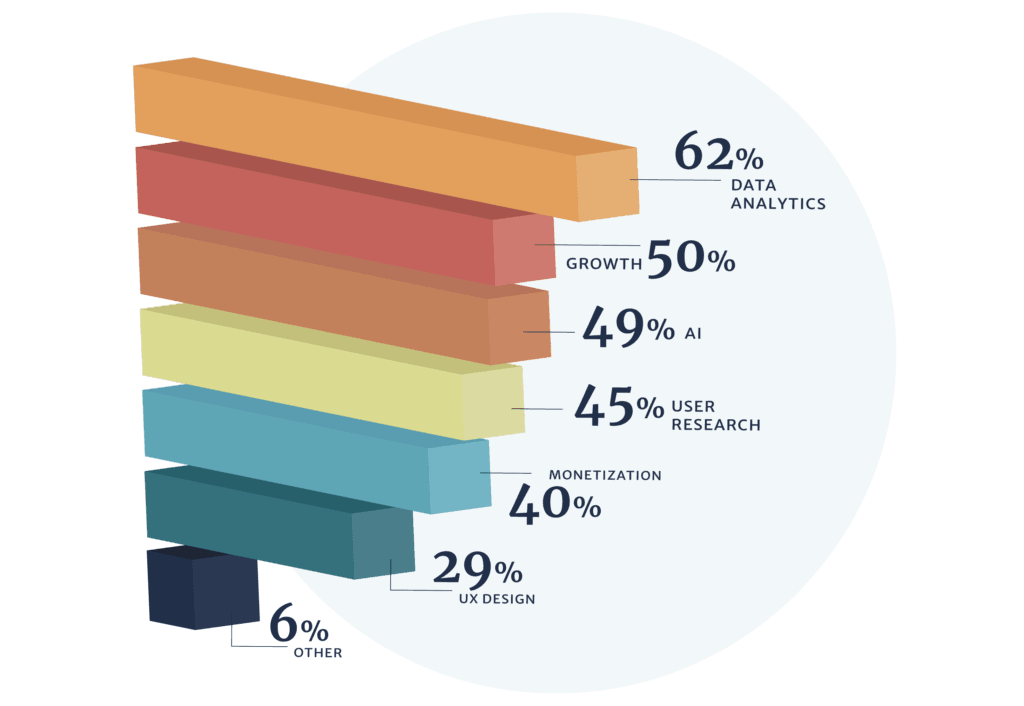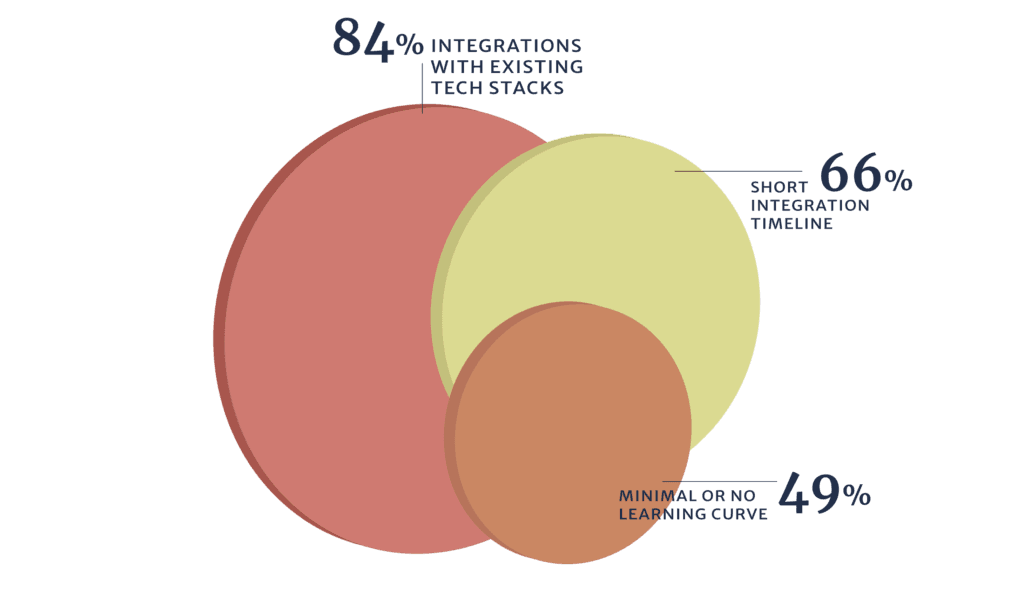Updated: May 6, 2024- 17 min read
The Future of Product Management Report launched last week with a bang. Within minutes of publication it landed on Product Hunt, rose to the top with hundreds of upvotes, and exceeded 3000 downloads before the close of launch day.
We started out with a hypothesis: there’s never been a better time to build digital products than right now. It was a daring statement to make amidst a pandemic, but we saw the signals were there and wanted to bring the truth to light.
1 survey, 20 questions, and 1500+ responses later, we had our answer. The Future of Product Management Report confirmed our suspicion, and the drivers behind it.
It shows that while the world stood still in 2020, product leaders raced ahead to accelerate roadmaps and ignite growth. It validates how in-demand PMs are with rising salaries in a field flourishing with opportunities to grow and thrive. It captures PM perspectives on what the future holds for their careers, tech, tools, leadership, goals, aspirations and more. And it reveals surprising insights about what product leaders are most concerned about, and where companies are falling short in motivating this talent.
Here are the top 5 trends:
Read on for the finer details driving each of these forces.
Respondent Breakdown
The survey included data from thousands of respondents across the Product School global community of product leaders.
The largest number chimed in from product hotspots of Silicon Valley, New York, and London ranging across different industries and global corporations to early-stage startups.
Companies included Apple, Google, Accenture, Allstate, American Express, Autodesk, Barclays, Bloomberg, Booking.com, Capital One, Hellofresh, Microsoft, Mercedes-Benz, SAP, Siemens, T Mobile, and Walmart to name a few.
This range of PMs offered a cross-section view of the future of hardware, software, and services-driven products across both B2B and B2C.
From this critical mass, we analyzed the data to get understand the most impactful factors shaping the road ahead.

Partners
This report was compiled by Product School in collaboration with some of the best product-led companies who were just as curious as us to discover what the future holds, including:

12 Key Findings Explained:
Here’s a breakdown of what PMs shared in the survey questions and implications for the future of product management.
Finding #1: 2020 solidified PMs in the driver’s seat of digital transformation.
Vaccines were far from the only development effort moving at warp speed last year, with PMs confronting 2020’s overnight disruption head on. As shutdowns set in and companies scrambled, PMs played a pivotal role in (quite literally) pivoting to the new normal as growth drivers to get through the unprecedented year.
Case in point? Half of product teams accelerated roadmaps directly in response to COVID-19. In contrast to industries forced to lock down, PMs found themselves uniquely capable of doing the opposite–ramping up. Called upon to bring about an acceleration desperately needed by their companies, they moved to develop faster, expedite go-to-market plans, all while adjusting to 100% remote work amidst a global pandemic.
Not stopping there, PMs played an outsize role in enabling the digital transformation and innovation forced on their organizations. As Microsoft CEO Satya Nadella put it: “We experienced two years’ worth of digital transformation in two months.” And PMs were at the forefront, with 59% agreeing: “Product Management is the main driver of innovation/digital transformation in my company.” This means that beyond products alone, PMs assumed the role of visionaries and architects unlocking transformation needed to succeed in a profoundly changed world.
What does this mean beyond 2020?
Last year PMs established themselves as even more central, strategic and growth-driving functions in their organization. And there’s no going back. They’ll be leading the charge as companies contend with the unknowns and uncertainties of the digital world ahead. No longer riding shotgun, product is here to stay in the driver’s seat of monetization and growth long-term.

Finding #2: Product is still art, but increasingly a science.
In the great debate over PM as art or science, PMs signaled the role is becoming more scientific to deliver on strategy and growth objectives. While signals have been mixed in years past with arguments on both sides, the trendline is now pointing to science.
Almost half agree that product management is a science, signs of the pendulum swinging as product assumes an unquestionably central and strategic role. More formalized best practices are being shared and standardized across the field, turning the craft into more of a scientific practice vs. ad hod art form.
As for the other 19% still classifying product as an art? They remind us that while the product craft may indeed be scientific, it nonetheless demands both left and right brain thinking to take on the unknowns of the future.
Spoiler alert: if you’re wondering whether this means PMs require a scientific or technical background too, the short answer is no. (Read on for why!)

Finding #3: Salaries and hiring are on the rise.
Put plainly: PM is a hot job that’s in demand and getting paid more.
Here’s what the numbers say: Salaries are 3x higher than the U.S. mean average, and over 55% of respondents say they’re hiring more PMs in the first half of 2021.
Comparing PM against other occupations puts this into further perspective. Data from Linkedin and the upcoming Amplitude “Product Management Salary Report” (coming early March) show its strong standing vs other roles:

Product ranks in the higher tiers of well-compensated professions, proving resilient against the cutbacks and hiring freezes that so many roles faced in the pandemic. Plus, teams are hiring! Over half say they plan to hire at least 1 new PM in the first 6 months of 2021. That’s a remarkable statement that can’t be said for most other roles still reeling from the pandemic’s economic fallout.
Advice for PMs: If you’ve been considering making a move, it’s fair to say you can dust off that resume and feel confident venturing forth. And if you’re happy where you are, read on for why those prospects are equally as bright.
Finding #4: Breaking into product now possible for more backgrounds than ever.
The trendline is clear that backgrounds are reshaping and the typical PM “persona” is no longer one-size-fits-all. It turns out today’s PMs come from many backgrounds, including engineering, computer science, business, design, and more.
PMs entering the field are breaking the mold from the older blueprint of engineers and “MBAs only” with less rigid entry criteria. While two-thirds agree that technical/engineering degrees or MBA’s offer an edge in the job market, the range of distinct backgrounds strongly signal that a technical degree is not a fixed prerequisite, nor is an MBA or PhD.
The proliferation of low-code, visual tools is a key contributor to this trend. These highly-accessible systems don’t require coding skills and are fast becoming the preferred tools of the trade. And it’s a key enabler for PMs of many backgrounds to hit the ground running with universally user-friendly tools they can quickly adopt.
Bottom line: Future PMs will break the mold further arriving in all sizes, shapes, flavors to make their mark on the field.
Finding #5: Product career paths offer many ways to grow, namely three key tracks: individual contributor, people manager, and entrepreneurship.
The scope of career options is widening and PMs can choose the right path for their distinct personality type and long-term goals. Whether they want to manage people, found a company, or be an individual contributor, product careers are now a “choose your own adventure” filled with options to grow and thrive.
To dig into this, we asked: “Where do you see yourself in 5 years?” Answers show there are three main career tracks:

We dug further to find out the sequence of steps along those journeys and what job titles they involve. Here’s what those look like:
All paths typically start out rising through Associate PM, PM and Senior PM roles
From there, journeys often split off as some product leaders set out to found and lead their own companies as CEO
Individual contributors that stay on the corporate track typically progress upward to Principal PM
And people managers generally rise to Director and VP of Product, and even Chief Product Officer or CEO

Where did these PMs specifically say they’re heading next? Here’s the breakdown:
The majority plan to stay in product, validating that this is a field where they want to stay for the long-haul.
Within that, 37% plan to grow into managing a product team, showing the large proportion of leadership-minded PMs. 1
10% don’t aspire to people management and see themselves staying in product growing as individual contributors.
29% also plan to be team leaders but expand beyond product into other disciplines. This signals how the product is increasingly a cross-disciplinary function spanning “many hats” including strategy, marketing, sales, and support–experience that opens doors to career moves in many different directions.
20% say they’re headed for the CEO role itself as they branch out and found their own companies by 2026.
Others plan on becoming full-time board members, VCs, instructors, and
even transition happily into retirement.
Far from a one-way path, PMs are enjoying the wide opportunities to steer their future course in whatever direction suits them best.

Finding #6: The C-Suite may soon be the “Product Suite” with more PMs at the table than ever.
Recognition of product’s place on the executive team is growing with more product leaders rising to CEO and CPO, and PMs growing into GMs with expanded responsibilities.
16% of our respondents are lead by CEO’s from product backgrounds, and 31% companies have official CPO’s on their executive teams. Virtually unknown just a few years ago, the Chief Product Officer (CPO) role is gaining recognition as a necessary function in some organizations. And as more CEO’s rise the ranks from product, this means more clout, influence, and decision-making potential driven by product thinkers. Product literally has a seat at the table (or many) to make decisions and define culture for the wider company.
Looking ahead, the management aspirations of 66% PMs signals a full pipeline of up-and-coming executives will continue this trend in the future.
PMs: go ahead and add CPO to your vision board, or CEO while you’re at it.


Finding #7: It’s an all-out sprint towards Product-Led Growth.
If product leaders are firmly established in the C Suite, does this mean sales and marketing-driven cultures will soon be dominated by product-led growth strategies?
Survey says? Yes.
The rise of the product-led growth (PLG) strategy has gained popularity as companies prioritize the customer experience and leverage their product as the primary source of growth. Research from the Product-Led Collective and others have proven its profitability and customer acquisition benefits vs sales-led or marketing-led companies. So with product now in the C-Suite it’s no surprise that many go-to-market strategies are doubling down on PLG.
In our survey, over 73% describe their companies as “product-led” with products fueling revenue generation.
Asked to rate “How Product led is your company?” the majority of respondents are moving towards PLG at different rates. 9% say they are “Completely product-led” and “All In.” Another 64% are heading this way, either “Mostly product-led” or “Slowly moving in that direction.” While 23% are still driven by sales and marketing cultures, the overall indicators are clear that products are increasingly viewed as the most critical growth mechanism to attract and keep users long-term.
As Pendo CEO Todd Olsen summed it up: “Product management is really the shepherd for the product-led organization. Product teams provide the people, processes and data to help their companies embrace automation, which leads to better products that people actually use.”
Finding #8: Product teams are evolving in complexity, with the rise of “Growth PM” and other specialized roles.
Does your org chart include a “Growth PM”? How about Product Operations and Product Marketing? More product organizations are adding these nontraditional roles.
Job postings are circulating on Indeed and LinkedIn for “Growth PMs” and high-popularity niche roles barely visible just a few years ago. These specialized, hybrid-offshoot roles from the typical product track underscore how organizations are becoming more complex as companies shore up monetization strategy, business models, and communications with critical product hires.
Hiring managers: get your business case ready to expand your team. Clearly the PM function has the ear of leadership as companies hire for these adjacent skillsets to ratchet up PLG and overall product success.
PMs: consider what these roles could mean for you. Instead of focusing on all things product, how might your path evolve by going down one of these specialized tracks? What personal interests and superpowers can you lean into and impact a targeted area of the business? Or could you even forge an entirely new path we’ll cover in next year’s report?
Amir Movafaghi, CEO of Mixpanel, commented on this trend: “People have made significant changes to the way they work, consume, and interact both with digital products, and with one another. There will be few moments as profound as this to shape the products that will lead categories for decades to come. Product managers are at the forefront of that.”

Finding #9: What PMs value most on the job (and where companies miss the mark): Learning and Mentorship.
What PM’s Value Most on the Job: Learning & Mentorship
Asked: “Cash compensation aside, what are the top 3 factors you value the most at work?” PMs voiced where their true priorities lie. While the #1 spot went to “Type of Product,” barely a percentage point behind it was Learning and Mentorship at the top of the list.
Almost 8 out of 10 ranked Learning and Mentorship as the critical factor they value most on the job. The fact that this beat out equity and company brand proves just how focused PMs are on their professional development above all.
The problem is, companies aren’t keeping pace. That leads us to one of the most striking revelations from the survey…

Where Companies are Falling Short: Investment in PM Learning
Even though PMs value learning above almost everything else:
Just 40% of companies invest in formal education stipends, meaning less than half are meeting PM needs when it comes to learning and development (L&D) budgets.
It’s a glaring gap between what PMs want and what they’re getting from their companies.
HR teams, hiring managers, and company leadership: here’s your wake-up call. Building competitive, innovative products relied on for PLG is no easy feat. And PMs are voicing their need for L&D to support them on the way. Failing to deliver on such a highly valued factor for a growth-driving function risks attracting, retaining, and motivating PMs for success.
L&D teams take note: product is evolving into multi-dimensional, complex role that requires coaching, shaping and investment. Don’t shortchange those doing the job that are crying out for this support.
Product School CEO Carlos Gonzalez de Villaumbrosia weighed in to say: “Product Managers are lifelong learners by nature and motivated by big challenges. Put differently, no great Product Manager will stay long in a company that doesn’t invest in their own personal growth.”

Finding #10: Analytics is the next frontier, but raw data isn’t enough.
If PM is an increasingly vital function, what skills will matter most in the immediate future?
Asked to rank the top 3 hard skills they want to get better at, 62% of PMs prioritized Data Analytics as their #1, followed by Growth and AI. Notably, these far outrank traditionally technical skills like Coding and User Research, underlining how broader-reaching business skills are the more urgent imperative for the near future.
The consensus around Data Analytics as #1 echoes how data now holds an essential oxygen-like role for product leaders. But it’s important to read between the lines here. Raw data alone won’t suffice because a PM’s time is money (literally) demanding action-ready insights delivered as fluid, accessible experiences.
This has key implications for tech vendors: PMs are expecting more than raw Data Scientist-level data and crave an accessible, shorter path to insights. Getting to what’s inside the numbers with recommendations, predictive analytics and the “where, when and how” to extract its value is the end goal. Vendors should consider this the new scorecard for PM technology decisions.
As Matin Movassate, co-founder and CEO of Heap, observed: “Data shouldn’t be just for data teams – it should be for everybody. Especially product managers! While useful data and insights were once available only to people with technical backgrounds, they’re now there for anyone who wants it. In 2021, product analytics tools will do even more of the work for you.”

Finding #11: Tech must be low-code/no-code, visual, and integrated
Right now the PM tech and tool landscape is multiplying, but one capability reigns supreme: low-code/no-code experiences. Tools must be visual, accessible, and minimize or entirely eliminate the need to code.
49% of PMs cited “Minimal or no learning curve” as a critical factor when it comes to investing in tech and tools. This strong percentage makes clear how accessible, visual tools that lessen the need for technical backgrounds are emerging as the go-to for the PM tech stack.
This builds on the growth in tools geared specifically for PMs. Product leaders no longer need to piggyback off tools built for other functions (Excel, Photoshop, etc.) thanks to an entire new category catering specifically to product needs. And as they build their stacks with tools for roadmaps, wireframing, data analysis, and more it’s low-code/no-code that has emerged as the killer feature.
Vendors don’t delay: Gartner forecasts low-code/no-code will account for over 65% of application platforms by 2024, making it a non-negotiable factor when selling to PMs.

Finding #12: PMs to vendors: integrate or be passed over.
For tech and tools, you can sum it up like this: No integration? No consideration.
Loud and clear PMs signaled the importance of easily-integrated tools. In fact they ranked it priority #1 and #2 when it comes to tech and tool investments.
We asked: “Price and functionality aside, what are the top 3 factors your Product team values the most when purchasing a new tool?” 84% ranked “Integration with existing tech stack” as their #1 criteria, and 66% said “Short integration timeline” as #2.
Notably, we wondered if the proverbial HIPPO in the room (highest paid person’s opinion) might outweigh this, but its low ranking makes it clear that product teams have strong autonomy to set their own decision factors. And those factors leave no room for doubt: decisions start and end with integration.
The vendor implication is clear: tools that don’t sync with the stack won’t even be considered in the future.
Mariano Suarez-Battan, Co-founder and CEO of Mural, sees it like this: “Collaboration is more important than ever as more companies are embracing remote work. Design thinking methodologies and no code tools empower users to co-create solutions in a visual way. Ultimately, this helps entire organizations unlock innovation at scale.”

Conclusion
If we had to sum it up in a few words, the future of product management is:
Synonymous with growth, visual-first-data-everywhere, unquestionably critical function.
Beyond stakeholders in the company’s future and crucial drivers defining the next normal
A shared purpose uniting product leaders with their C-Suites, HR teams, companies, and vendors striking back against unknowns, and forward undeterred in pursuit of product-led growth.
Want action items, deeper analysis and more insights? Then you’ll just have to read the report itself. Download it now and dig in! Get the full report!
Updated: May 6, 2024





